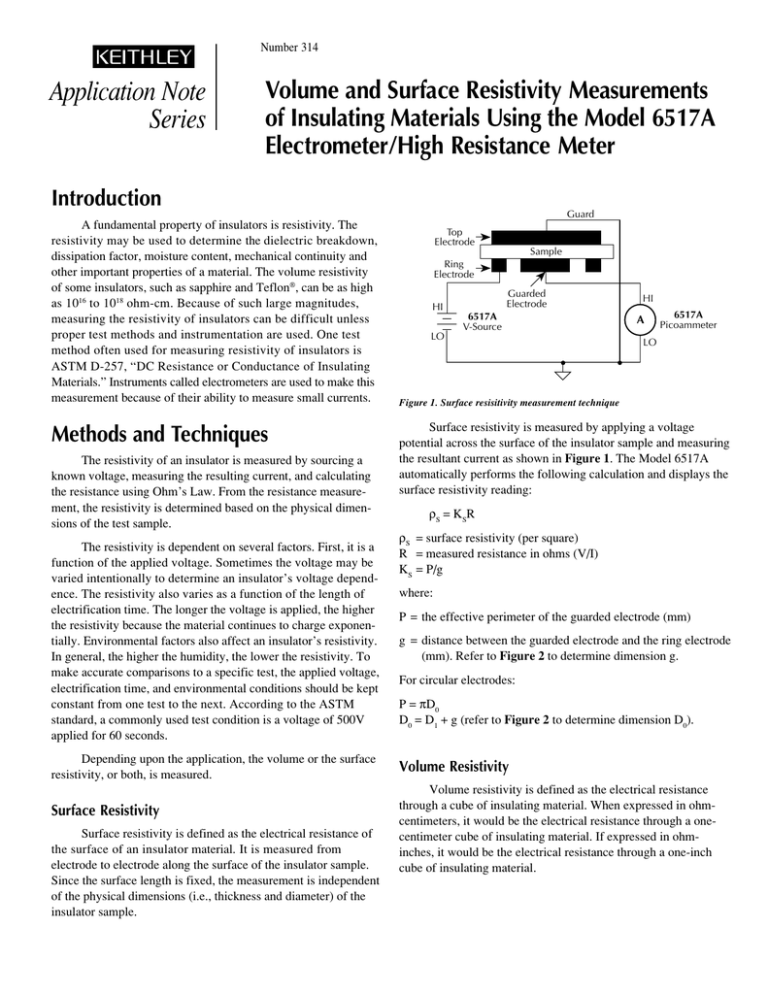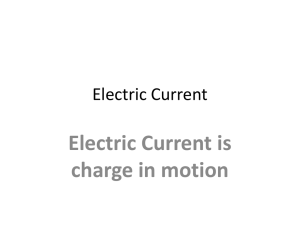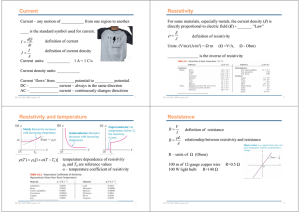Volume and Surface Resistivity
advertisement

Number 314 Application Note Series Volume and Surface Resistivity Measurements of Insulating Materials Using the Model 6517A Electrometer/High Resistance Meter Introduction A fundamental property of insulators is resistivity. The resistivity may be used to determine the dielectric breakdown, dissipation factor, moisture content, mechanical continuity and other important properties of a material. The volume resistivity of some insulators, such as sapphire and Teflon®, can be as high as 1016 to 1018 ohm-cm. Because of such large magnitudes, measuring the resistivity of insulators can be difficult unless proper test methods and instrumentation are used. One test method often used for measuring resistivity of insulators is ASTM D-257, “DC Resistance or Conductance of Insulating Materials.” Instruments called electrometers are used to make this measurement because of their ability to measure small currents. Methods and Techniques The resistivity of an insulator is measured by sourcing a known voltage, measuring the resulting current, and calculating the resistance using Ohm’s Law. From the resistance measurement, the resistivity is determined based on the physical dimensions of the test sample. The resistivity is dependent on several factors. First, it is a function of the applied voltage. Sometimes the voltage may be varied intentionally to determine an insulator’s voltage dependence. The resistivity also varies as a function of the length of electrification time. The longer the voltage is applied, the higher the resistivity because the material continues to charge exponentially. Environmental factors also affect an insulator’s resistivity. In general, the higher the humidity, the lower the resistivity. To make accurate comparisons to a specific test, the applied voltage, electrification time, and environmental conditions should be kept constant from one test to the next. According to the ASTM standard, a commonly used test condition is a voltage of 500V applied for 60 seconds. Depending upon the application, the volume or the surface resistivity, or both, is measured. Surface Resistivity Surface resistivity is defined as the electrical resistance of the surface of an insulator material. It is measured from electrode to electrode along the surface of the insulator sample. Since the surface length is fixed, the measurement is independent of the physical dimensions (i.e., thickness and diameter) of the insulator sample. Guard Top Electrode Sample Ring Electrode HI LO Guarded Electrode 6517A V-Source HI A 6517A Picoammeter LO Figure 1. Surface resisitivity measurement technique Surface resistivity is measured by applying a voltage potential across the surface of the insulator sample and measuring the resultant current as shown in Figure 1. The Model 6517A automatically performs the following calculation and displays the surface resistivity reading: ρS = KSR ρS = surface resistivity (per square) R = measured resistance in ohms (V/I) KS = P/g where: P = the effective perimeter of the guarded electrode (mm) g = distance between the guarded electrode and the ring electrode (mm). Refer to Figure 2 to determine dimension g. For circular electrodes: P = πD0 D0 = D1 + g (refer to Figure 2 to determine dimension D0). Volume Resistivity Volume resistivity is defined as the electrical resistance through a cube of insulating material. When expressed in ohmcentimeters, it would be the electrical resistance through a onecentimeter cube of insulating material. If expressed in ohminches, it would be the electrical resistance through a one-inch cube of insulating material. Standard Method Resistivity Tests (Surface and Volume) This test is used to measure the resistivity (surface or volume) of an insulator sample. When used with the Model 8009 Resistivity Test Fixture, the test conforms to the ASTM D-257 standard. Figures 1 and 3 show the test circuits for the respective measurements, and Figure 4 shows the connections to the Model 8009. Refer to the instruction manual for the Model 8009 to install the insulator sample in the test fixture. When this test is run, the V-Source will initially be set to source 0V for a specified time (PRE-DISCH time) to allow any charge to dissipate. The V-Source will then apply a specified voltage (BIAS V) to the electrodes of the test fixture for a specified time (BIAS-TIME). This “bias” period allows currents in the test circuit to stabilize. The V-Source then applies the test voltage (MEAS-V) and, after a specified delay (MEAS-TIME), the Model 6517A measures the resistivity of the sample and stores the reading in the buffer. Note that the test voltage (MEASV) is typically at the same level as the bias voltage (BIAS-V). The Surface Resistivity Test and the Volume Resistivity Test are selected and configured from the CONFIGURE SEQUENCE menu (R/RESISTIVITY; NORMAL; SURFACE and VOLUME). Alternating Polarity Resistance/Resistivity Test The Alternating Polarity Resistance/Resistivity test is designed to improve high resistance/resistivity measurements. These measurements are prone to large errors due to background currents. By using an alternating stimulus voltage, it is possible to eliminate the effects of these background currents. This test will measure surface or volume resistivity or resistance, as selected in the CONFIGURE RESISTANCE menu. Figures 1 and 3 show the test circuits for the respective measurements, and Figure 4 shows the connections to the Model 8009. Refer to the Model 8009 Instruction Manual for information on installing the sample in the test fixture. When this test is run, the V-Source will alternate between two voltages (V-OFS + V-ALT) and (V-OFS - V-ALT) at timed intervals (MEAS-TIME). Current measurements are taken at the end of each of these alternations and after calculation of Icalc resistance values are computed. Icalc is a weighted average of the latest four current measurements, each at the end of a separate alternation. The resistance value is then converted to a resistivity value if the meter has been configured for resistivity measurements. The first few readings can be rejected (DISCARD XXX RDGS) as the sample or resistance achieves a steady-state response to the alternating voltage. After this, the alternation will continue until a specified number of readings (STORE XXX RDGS) have been stored in the buffer. The time required to complete a sequence is (STORE + DISCARD + 4) × MEASTIME. For example, a sequence alternating at 15 second intervals, discarding three readings, and storing three readings will take 2.5 minutes. Figure 5 shows an example of the Alternating Polarity test using the test parameters shown and the resulting sample current from a typical high resistance sample. Note that the sample currents shown exhibit some capacitive delay, as many high resistance samples also tend to have significant capacitance. 6517-ILC-3 Interlock Cable WARNING:NO INTERNAL OPERATOR SERVICABLE PARTS,SERVICE BY QUALIFIED PERSONNEL ONLY. Model 8009 LO PREAMP OUT COMMON ! INPUT HI V SOURCE 250V PEAK 250V PEAK METER SOURCE TRIAX 250 MAX HI-LO MAX INPUT 1100V LINE RATING 90-134VAC 180-250VAC 50, 60, 400HZ 55VA MAX LID ! INTERLOCK LINE FUSE SLOWBLOW 1/2A, 250V IEEE-488 (CHANGE IEEE ADDRESS WITH FRONT PANEL MENU) ! OUT INTERLOCK 7078-TRX-3 Triax Cable CAUTION:FOR CONTINUED PROTECTION AGAINST FIRE HAZARD,REPLACE FUSE WITH SAME TYPE AND RATING. Model 6517A 8607 Banana Plug Cables Warning: Connect of fixture to safety earth ground using safety ground wire (supplied with 8002A test fixture). Figure 4. Connections for measurements using Model 8009 Test Fixture Ring Electrode Guarded Electrode Sample g Top Electrode Ring Electrode D 1 D0 D 2 HI 6517A V-Source LO D2 D0 D1 Guarded Electrode HI A Guard 6517A Picoammeter LO Figure 3. Volume resistivity measurement technique Sample Guarded Electrode g g= D1 – D 2 2 Ring Electrode D0 = D 1 + g Test Fixture Dimensions (cm) Model 8009 D1 2.000 in D0 2.125 in D2 2.250 in g 0.125 in Figure 2. Circular electrode dimensions Volume resistivity is measured by applying a voltage potential across opposite sides of the insulator sample and measuring the resultant current through the sample as shown in Figure 3. The Model 6517A automatically performs the following calculation and displays the volume resistivity reading: KV ρV = ___ R τ ρV = volume resistivity KV = the effective area of the guarded electrode for the particular electrode arrangement employed τ = average thickness of the sample (mm) R = measured resistance in ohms (V/I) For circular electrodes: KV = π ( D1 g +B 2 2 2 ) D1 = outside diameter of guarded electrode g = distance between the guarded electrode and the ring electrode B = effective area coefficient Notes: 1. Refer to Figure 2 to determine dimensions D1 and g. 2. An effective area of coefficient (B) of 0 is typically used for volume resistivity. Instrumentation As discussed, these measurements are made using an electrometer or picoammeter, voltage source, and a resistivity chamber, as shown in Figure 1. The Keithley Model 8009 Resistivity Chamber contains an electrode configuration like the one shown in Figure 2. In the chamber the electrodes are located in a shielded box to minimize stray electrostatic pick-up, which can cause measurement errors. The electrodes are made of stainless steel and are built to ASTM standards. If the sample is made out of rigid material, such as glass, epoxy or ceramics, and the electrodes are also rigid, conductive rubber may be needed to make a better contact between the electrodes and the surface of the material. The electrodes in the 8009 Resistivity Chamber are already covered with conductive rubber. The recommended sample size for these fixtures is three to four inches in diameter. The ASTM procedure also describes several other electrode configurations, depending on the size and shape of the specimen. The ammeter is connected to the resistivity chamber using low noise cabling. Most of the cables and adapters needed to make the measurements are included with the chamber. The 6517A includes a built-in voltage source. Tests The following test sequences are built into the Model 6517A for use with the Model 8009: Test System Safety When the Alternating Polarity sequence is first armed by pressing SEQuence and then ENTER, the settings for the current measurements made internally to the sequence are preset to the settings for the amps function. If the amps function is set to a specific range, the sequence defaults to that range. If the amps function is autoranging, the sequence will default to autoranging. The range can be changed after the sequence is armed by pressing the ▲, ▼, or Auto keys. The Alternating Polarity sequence will not autorange past the 2nA range. If the resistance/resistivity to be measured is high and a more sensitive range is required, the user must set this range manually using the ▲ or ▼ keys. (For the 20pA and 200pA ranges, use a measure time of at least 15 seconds.) Many electrical test systems or instruments are capable of measuring or sourcing hazardous voltage and power levels. It is also possible, under single fault conditions (e.g., a programming error or an instrument failure), to output hazardous levels even when the system indicates no hazard is present. These high voltage and power levels make it essential to protect operators from any of these hazards at all times. Protection methods include: • Design test fixtures to prevent operator contact with any hazardous circuit. While in the armed condition, the sequence parameters may be changed (CONFIG-SEQ…), the range may be changed, the output result type may be changed (resistance, surface, or volume resistivity), and the resistivity parameters edited. To run the sequence, press TRIG after arming. Pressing EXIT after arming disarms the sequence, and returns the Model 6517A to the function in use when it was armed. During execution, the sequence will show “--------” until the first reading becomes available and is sent to the buffer. After this, the latest calculated value will be displayed. If, at the end of any alternation the current exceeds the amps range in use, the error +618 Resistivity:I OutOfLimit will occur and the sequence will abort, returning it to the function in use before it was last armed. If the Alternating Polarity sequence calculates a current of zero, “<Infinity>” will be displayed, but the sequence will continue. A lower current range should be selected. The Alternating Polarity test is selected and configured from the CONFIGURE SEQUENCE menu (APPLICATIONS; R/ RESISTIVITY; ALT-POLARITY). • Make sure the device under test is fully enclosed to protect the operator from any flying debris. • Double insulate all electrical connections that an operator could touch. Double insulation ensures the operator is still protected, even if one insulation layer fails. • Use high reliability, fail-safe interlock switches to disconnect power sources when a test fixture cover is opened. • Where possible, use automated handlers so operators do not require access to the inside of the test fixture or have a need to open guards. • Provide proper training to all users of the system so they understand all potential hazards and know how to protect themselves from injury. It is the responsibility of the test system designers, integrators, and installers to make sure operator and maintenance personnel protection is in place and effective. 15 10 5 0 Current pA Icalc Imeas Background –5 Voltage –10 –15 +50V –50V –20 0 30 60 90 120 Figure 5. Specifications are subject to change without notice. All Keithley trademarks and trade names are the property of Keithley Instruments, Inc. All other trademarks and trade names are the property of their respective companies. Keithley Instruments, Inc. • 28775 Aurora Road • Cleveland, Ohio 44139 • 440-248-0400 • Fax: 440-248-6168 1-888-KEITHLEY (534-8453) www.keithley.com © Copyright 2001 Keithley Instruments, Inc. Printed in the U.S.A. No. 1680 8012KDCI





